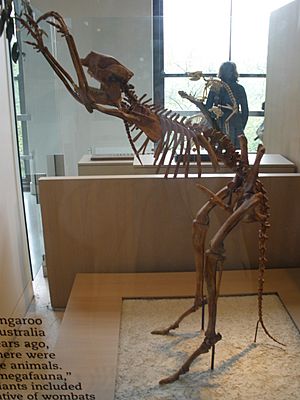Simosthenurus occidentalis facts for kids
Quick facts for kids Simosthenurus occidentalis |
|
|---|---|
| Scientific classification |
Simosthenurus occidentalis was a type of ancient kangaroo that lived in Australia a very long time ago. It was much heavier than the kangaroos we see today, weighing about 118 kilograms! This amazing animal became extinct around 42,000 years ago. Scientists call it a "short-faced kangaroo" because of its unique skull and teeth, which helped it eat tough plants, much like a koala or a panda bear.
Contents
Discovering the Short-Faced Kangaroo
The first fossil of Simosthenurus occidentalis was found by E. A. Le Souef. Ludwig Glauert officially described it in 1910. This first fossil, called the "holotype," was part of an adult jaw found in Mammoth Cave in Southwest Australia. The name occidentalis means "of the west," because it was discovered in Western Australia.
What Did It Look Like?
Simosthenurus occidentalis was a medium-sized member of the 'short-faced' kangaroo family. Adults weighed around 118 kilograms. They were as tall as large modern kangaroos but had a much heavier and stronger body.
Special Teeth for Tough Plants
This ancient kangaroo had very strong teeth, especially its molars. These molars were set close to the back of its jaw. This special tooth and skull structure meant it could eat tough plants. Unlike modern kangaroos that mostly eat grass, Simosthenurus occidentalis was a "browser." This means it ate leaves, bark, and branches, similar to how a modern koala eats eucalyptus leaves.
Its powerful molars were positioned to give it a strong bite. The shape of its forehead and strong cheekbones helped spread out the force when it bit down. This allowed it to tear and chew very tough, fibrous plant material. Scientists found that its skull and teeth were most like those of a giant panda. Pandas also mainly eat tough plant material, like bamboo.
Where Did It Live?
Fossils of Simosthenurus occidentalis have been found in many places across southern Australia. This includes sites in Tasmania and even King Island. The very first fossil was found in Mammoth Cave in Southwest Australia. Evidence shows it lived in this area until about 42,000 years ago. Its fossils have been found in the southwest, central, and southeast parts of Australia.
This species lived during the Pleistocene epoch, a time when many large animals roamed the Earth.


